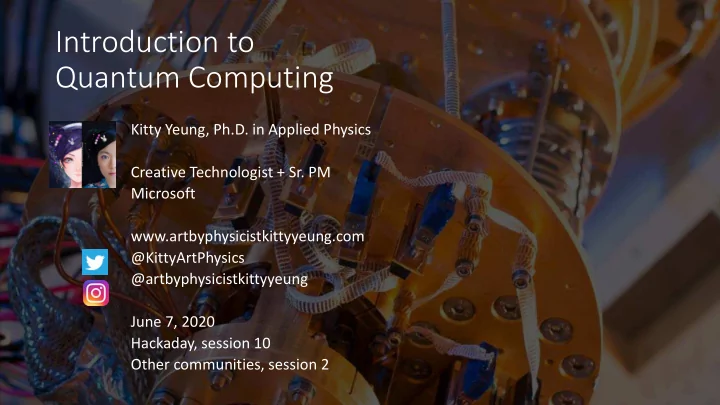

Introduction to Quantum Computing Kitty Yeung, Ph.D. in Applied Physics Creative Technologist + Sr. PM Microsoft www.artbyphysicistkittyyeung.com @KittyArtPhysics @artbyphysicistkittyyeung June 7, 2020 Hackaday, session 10 Other communities, session 2
Class structure • Comics on Hackaday – Introduction to Quantum Computing every Sun • 30 mins – 1 hour every Sun, one concept (theory, hardware, programming), Q&A • Contribute to Q# documentation http://docs.microsoft.com/quantum • Coding through Quantum Katas https://github.com/Microsoft/QuantumKatas/ • Discuss in Hackaday project comments throughout the week • Take notes
Graphic representation of a qubit
Graphic representation of a qubit
Graphic representation of a qubit
Bloch sphere Arbitrary state 𝜔 = cos 𝜄 0 + 𝑓 −𝑗𝜚 sin 𝜄 | ۧ 2 | ۧ 2 | ۧ 1 the states | ۧ 0 and | ۧ 1 are just two special cases with θ = 0 ° and 180 ° , respectively.
Gates (quantum operations)
General rotation In general, rotation gates, R, about an axis can be described by the angles 𝜚 and 𝜄 : 𝑆 𝑨 𝜚 = 𝑓 −𝑗𝜚/2 0 𝑓 𝑗𝜚/2 , 0 𝜄 𝜄 cos − sin 2 2 𝑆 𝑧 𝜄 = , 𝜄 𝜄 sin cos 2 2 and cos 𝜄 −𝑗 sin 𝜄 2 2 𝑆 𝑦 𝜄 = −𝑗 sin 𝜄 cos 𝜄 https://review.docs.microsoft.com/en- 2 2 us/quantum/concepts/the-qubit?branch=tensor-product 𝜌 𝜌 = 𝑆 𝑨 2 𝑆 𝑧 𝜄 𝑆 𝑨 − 2 .
Pauli gates 𝑌 = 0 1 1 0 𝑌 𝑏 = 𝑐 𝑐 𝑏
Pauli gates 𝑌 = 0 1 𝑍 = 0 −𝑗 1 0 𝑗 0 𝑌 𝑏 𝑍 𝑏 = 𝑐 = 𝑗 −𝑐 𝑐 𝑐 𝑏 𝑏
Pauli gates 𝑌 = 0 1 𝑍 = 0 −𝑗 𝑎 = 1 0 1 0 𝑗 0 0 −1 𝑎 𝑏 𝑏 𝑌 𝑏 𝑍 𝑏 = 𝑐 = 𝑗 −𝑐 = 𝑐 −𝑐 𝑐 𝑐 𝑏 𝑏
Hadamard H 1 1 2 2 𝐼 = 1 − 1 2 2
Hadamard H 1 1 1 1 1 2 2 2 2 𝐼| ۧ 0 = 𝐼 = 1 1 0 − 1 − 1 2 2 2 2 1 1 0 1 1 2 = = 0 + 1 1 2 2 2 1 2 (| ۧ 0 + | ۧ 1 ) ≡ | ۧ = + 1 1 0 2 2 𝐼| ۧ 1 = 1 1 1 − 2 2 1 2 (| ۧ 0 − | ۧ 1 ) ≡ | ۧ = − .
Hadamard revisit
Q# exercise: Option 1: No installation, web-based Jupyter Notebooks • The Quantum Katas project (tutorials and exercises for learning quantum computing) https://github.com/Microsoft/QuantumKatas • BasicGates • Tasks 1.1-1.3 • Task 1.4 (p9), 1.5 (p15) • Task 1.6, Microsoft.Quantum.Intrinsic https://review.docs.microsoft.com/en-us/qsharp/api/qsharp/microsoft.quantum.intrinsic • Task 1.7 (p5) Microsoft.Quantum.Math • Tutorial https://github.com/microsoft/QuantumKatas/tree/master/tutorials/SingleQubitGates
For certificate 1 • Complete any one quantum kata • Take a screenshot or photo • Post on Twitter or LinkedIn • Tag the following • Twitter: @KittyArtPhysics @MSFTQuantum @QSharpCommunity #QSharp #QuantumComputing #comics #physics • LinkedIn: @Kitty Y. M Yeung #MSFTQuantum #QSharp #QuantumComputing #comics #physics
Participate • Dr. Sarah Kaiser is doing Q# coding live every Wed and Sat at 12pm PT. Check them out! https://www.twitch.tv/crazy4pi314 • Microsoft Q# coding contest is happening from June 19 to June 22, 2020. Register now! https://codeforces.com/blog/entry/77614
aka.ms/learnqc https://www.microsoft.com/quantum/development-kit
Next class
Questions • Post in chat or on Hackaday project https://hackaday.io/project/168554-introduction-to-quantum- computing • Past Recordings on Hackaday project or my YouTube https://www.youtube.com/c/DrKittyYeung
Recommend
More recommend